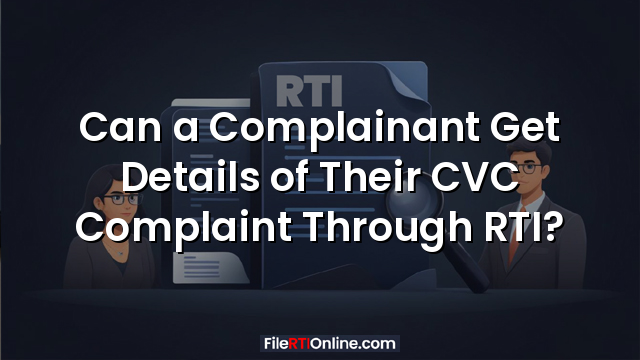Can a Complainant Get Details of Their CVC Complaint Through RTI? A Complete Guide
Many people file vigilance or corruption complaints with the Central Vigilance Commission (CVC) and later want to know what action was taken. However, CVC complaints—especially those filed under the Public Interest Disclosure and Protection of Informers (PIDPI) scheme—are treated as confidential.
This raises an important question:
Can the complainant themselves seek details of their CVC complaint under the Right to Information Act?
This article explains the legal position, what information can and cannot be shared, and includes a real CIC case where a complainant successfully obtained details of his own PIDPI complaints.
Understanding CVC Complaints and Confidentiality
The CVC handles:
- Corruption complaints
- Vigilance-related complaints
- PIDPI complaints (commonly called whistleblower complaints)
Under PIDPI, the identity of the whistleblower is strictly protected.
This confidentiality sometimes results in PIOs denying information, even to the original complainant.
Can the Complainant Access Their Own Complaint Details Under RTI?
Yes.
The Central Information Commission (CIC) has clarified that:
- The complainant has the right to know basic details about their own complaint.
- Denial is not justified when the information seeker is the same person who filed the complaint.
- Confidentiality rules apply mainly to third parties, not the complainant themselves.
However:
Certain sensitive documents, such as investigation reports, may still be withheld if exempt under:
- Section 8(1)(h) – information that may impede investigation
- Section 8(1)(g) – information that may endanger someone’s safety or reveal the source of information
So while the complainant can receive complaint numbers, forwarding letters, and status updates, they may not always receive detailed investigation reports.
Real Example: CIC Directs CVC to Share Complaint Details With the Complainant
Background of the Case
An applicant had filed many PIDPI complaints with the CVC. He later filed RTI applications requesting:
- Copies of forwarding letters
- Complaint numbers
- Investigation reports
The PIO rejected the request under Sections 8(1)(h) and 8(1)(g), claiming confidentiality and ongoing investigation.
Arguments Before the CIC
- Complainant’s argument:
Since he filed the complaints himself, the information should not be withheld from him. - CVC’s argument:
Their confidential section does not disclose such details to protect whistleblower identity.
CIC’s Findings
The CIC held:
- The complainant has the right to access his own complaint details.
Confidentiality rules exist to protect the complainant—not to block him from receiving his own information. - Complaint numbers, forwarding letters, and basic action taken must be shared.
- Investigation reports can be withheld only under valid exemptions, such as ongoing investigation.
CIC’s Directions
The PIO was instructed to:
- Collect information from the confidential section
- Provide complaint numbers
- Provide forwarding letters issued to other authorities
- Provide any other non-exempt information
This case establishes a clear precedent: a complainant cannot be denied access to the basic records of their own complaint.
What Information the CVC Must Provide to the Complainant
You are entitled to receive:
- Complaint registration number
- Date of forwarding to other authorities
- Copies of forwarding letters
- Basic status updates
- Details on whether the complaint was taken up, closed, or transferred
You may receive investigation reports only if they do not fall under exemptions.
What Information Cannot Be Disclosed
The following may be denied:
- Information that may reveal whistleblower sources (if multiple complainants exist)
- Sensitive investigation details
- Internal vigilance reports that may impede ongoing inquiries
- Details involving third-party officials unless the process is complete
How to Use RTI to Get Your CVC Complaint Status
Step 1: File RTI to CVC
Ask for:
- Complaint numbers
- Forwarding letters
- Current status
- Name of authority currently handling the case
Step 2: If Denied, File First Appeal
Mention that you are the original complainant, and Section 8 exemptions do not apply.
Step 3: File Second Appeal to CIC, If Needed
CIC precedents strongly support disclosure to the complainant.
You may cite this case as supporting authority.
Conclusion
If you have filed a complaint with the CVC—especially under PIDPI—you can request information about your own complaint through RTI. The CIC has made it clear that confidentiality rules should not be used against the complainant. Only sensitive investigative details may be exempt.
This ensures transparency for complainants while still protecting investigative integrity.


